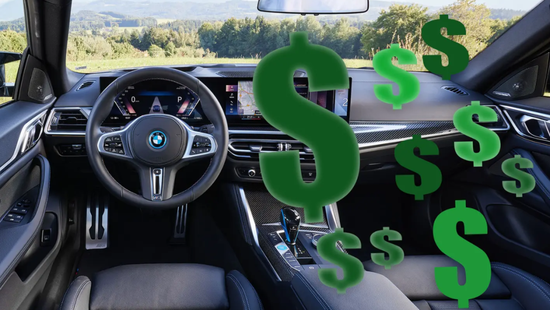 Title map source | The Drive
Title map source | The DriveWelcome to the WeChat subscription number of “Sina Technology”: techsina
Does the heated seat have to pay to unlock it? Where has the dignity of the car company gone?
Text|Editor by Du Chen|Vicky Xiao
Source: Silicon Stars
Recently, the automotive media Jalopnik wrote an article, pointing out that BMW has begun to “make up” again in the matter of paying and adding value:
In South Korea, the United Kingdom, New Zealand and other countries, BMW has begun to sell heated seats as a paid value-added feature. Taking the UK as an example, the price of a “subscription” heated seat service is £15/month (about $18 or 122 yuan), £150 a year, £250 for three years, and £350 for “indefinite use”.
The situation has been exaggerated to such an extent that some overseas BMW owners have used “illegal” means to find hackers or third-party repair shops with electronic unlocking capabilities to unlock these functions that should belong to them.
A British car modification expert said that there are many local car repair shops that can provide services such as unlocking heated seats, Apple CarPlay, and upgrading satellite navigation.
| The heated seats are also locked, where is the decency of car companies?
Such aftermarket modification services are indeed “illegal” from the perspective of car companies’ warranty, but their prices are much cheaper than the car companies’ own pricing, so they are quite common.
WIRED interviewed Iain Litchfield, founder of a well-known aftermarket accessories service brand. According to him, German car companies such as BMW, which are notorious for using paywalls, are also the most popular brands in these aftermarket “illegal” tuning services.
For example, CarPlay and related voice control functions, BMW’s paid subscription price sold by itself in the past few years is $80, and it is almost $48 to find a car repair shop in the UK to unlock it.
 In a BMW sedan, there are many pre-installed features that can only be unlocked with additional purchases Image credit: BMW
In a BMW sedan, there are many pre-installed features that can only be unlocked with additional purchases Image credit: BMWIn overseas markets, BMW has been criticized by a huge amount of public opinion for the issue of CarPlay payment, and finally announced in 2019 that it will no longer charge extra for CarPlay on 2020 and later models.
Do you think BMW is good at it? No, it’s even more outrageous. Because this time it’s finally eyeing heated seats.
In fact, heated seats have become an integral part of BMW’s new car production and assembly process. The fuses, heating coils, thermometers and other hardware related to the heated seats have been installed under the seats of every BMW new car. At the level of the car’s electrical circuits, activating a heated seat function is not substantially different from a “toggle switch.”
But what BMW wants to do now is to make you spend $18 a month in winter just to be able to flip the switch – if CarPlay was a software before, it can be paid for by “software as a service” (SaaS). Accepted logic to explain, then now BMW has turned heated seats into “hardware as a service”.
The anger of overseas netizens could not be contained.
“If a technological device is so cheap that resources can be wasted at will in manufacturing, installing, disabling it, and building paywalls for it…then it should be standard,” wrote Reddit user @Austaph.
“If it’s a feature like autonomous driving that requires continuous development and updates over the air, that’s fine. But there’s a separate charge for just such a heating coil and fuse? Whoever decides to do this should be fired immediately.”
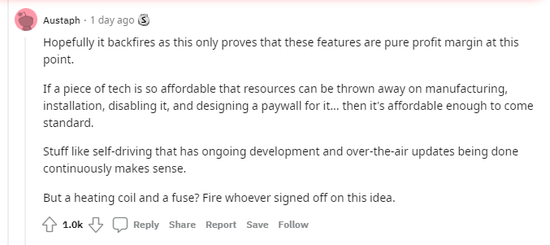 Screenshot credit: @Austaph/Reddit
Screenshot credit: @Austaph/RedditAdmittedly, anyone with a basic understanding of how a car works should understand that seat heating isn’t some sort of magic-like experience that just happens to be paid for.
But unfortunately, many car owners today only have a limited understanding of the car in the driving school. Apart from the fact that the car can run after refueling and the tires need to be inflated, they lack understanding of the working principle of the car. In addition, they have become accustomed to and accepted the transaction models such as value-added payment, micro-transaction, subscription-based payment, etc., which have become popular with the popularity of the mobile Internet, and many people themselves are the purchase model of loan/long-term rental (lease), which is nothing more than monthly Pay a little more.
In order to be able to drive the latest car, they are willing to accept this logic-distorted pricing strategy. There is also a key factor here. It is difficult for consumers to buy the styles and trim levels they want. Basically, they can only buy what the dealer has.
Because according to normal logic, when buying a car, you should tell the dealer to remove a series of value-added features such as heated seats and CarPlay, and then buy it at a price reduction of several thousand dollars.
“I think BMW might as well make the direction indicator into a value-added payment, no one uses it anyway,” a netizen complained.
| Industry-wide secrets of misappropriation
In the automotive market, the concept of subscription/paid upgrade function should be invented by Tesla first, and the most well-known should be a series of functions such as Autopilot, in-vehicle entertainment and communication systems of Tesla electric vehicles. All have to pay to unlock.
But Autopilot is okay, because it requires both hardware and complex on-board computer software functions, the hardware is already built-in, and additional fees for software activation are acceptable. And Tesla pioneered the concept of air-to-air software upgrades for cars, and it is also an innovator.
The bad thing is that a variety of traditional automakers have also begun to blindly follow this trend. Including General Motors, Volkswagen, Toyota, Audi, Porsche, etc., when they introduced new technologies such as driver assistance and voice control, they made these technologies into additional fees, and even some brands have provided functions that were “free” before. For example, automatic locks, etc., have been re-made into “upgrade packages”.
A GM executive revealed at an investor conference last year that at least 4 million car owners had paid for activation of various features, “If our marketing strategy is accurate, our consumers are willing to pay $135 a month for various products and products. Serve.”
This poor strategy is also common in the automotive aftermarket. For example, a car owner revealed that in the early years, the car audio launched by the Japanese brand Pioneer was divided into several grades. But if you remove the entry-level shell, you will find that Pioneer is very clever to use the shell to block the buttons corresponding to the functions of the advanced version.
Zooming in, similar strategies have become a common problem across the industry.
In the home audio and video entertainment industry, a common phenomenon in the past few years is that TVs and audio products of different price levels have similar functions. The unique functions of high-end products are actually low-end products. If you open the case, you will find that the circuit board switch corresponding to the button is there, but there is no button. After all, only one type of circuit board is produced.
In the field of cameras, Canon users should be familiar with Magic Lantern. The organization specializes in cracking Canon cameras, developing third-party firmware packages, and flashing older models to achieve features that are only available on newer and more expensive models, such as voice-activated shutter, time-lapse photography, RAW video, HDR video, and more.
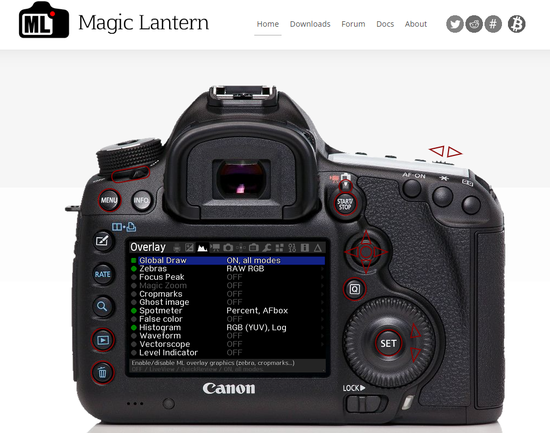 Image credit: Magic Lantern
Image credit: Magic LanternIn the early years, Xerox’s all-in-one printers were also divided into different price models. For example, there are two types of Document Center 220 and 230. The former can print 20 sheets per minute, and the latter can print 30 sheets. If you think that the difference lies in the motor and the image processor, then you have a high opinion of Xerox: you don’t even need to flash the firmware, you can directly adjust the printing speed by entering the hidden menu on the user interface of the machine.
Another example is a small knowledge of the chip industry: CPUs at different prices actually have not many internal components, but the quality of the wafer process is different, and the performance and price can be several times worse.
In recent years, some well-known chip brands have played to the extreme of frequency locking and function locking. For example, NVIDIA, the 4 series graphics cards in previous years are basically the same as the Quadro series of the same generation, and some advanced functions of the latter can be unlocked by driver modification, which is very simple.
But the simplest is the Athlon CPU launched by AMD in the early years. You can “unlock” the overclocking function by drawing lines on the board with a pencil and connecting two contacts.
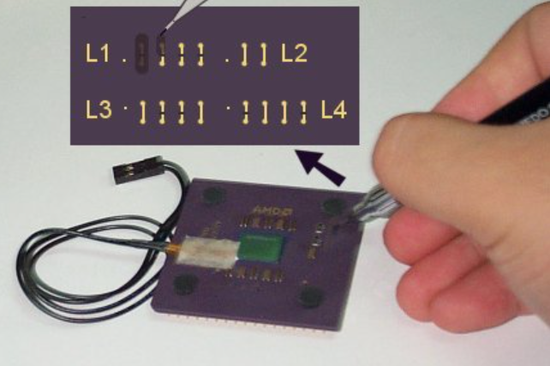 Image credit: Computers and Networks/Blogspot
Image credit: Computers and Networks/BlogspotFinally, we’re back to transportation, where another company recently made headlines for its outrageous pay-for-value-added services rules: French safety products company In&Motion has launched a $400 motorcycle airbag vest.
After the purchase, the car owner has to pay an additional subscription fee of $12/month (or $120/year), and before each use, you must log in to the app on your mobile phone to connect with the vest to verify the payment activation status, and the vest will work normally when the car crashes activation.
To put it another way: You have to pay to become a premium member to live (under the protection of this company).
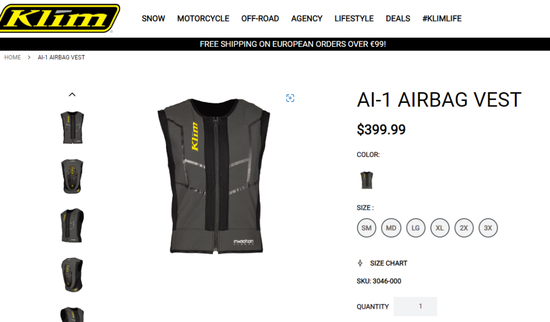
The company’s explanation is quite audible. It said that the starting price of other competing products is about twice or more than its own. This price is equivalent to lowering the threshold for motorcycle owners to obtain protection. And even if the user forgets to pay, there is still a one-month grace period, and the user can choose when to pay (for example, it is not safe to ride a motorcycle in winter. elasticity.
But this incident still brought a very bad impression to ordinary netizens.
“Thinking of BMW, I’m now worried that if the car brand makes the airbag a paid function in the future, it will be too sour…”

(Disclaimer: This article only represents the author’s point of view and does not represent the position of Sina.com.)
This article is reproduced from: http://finance.sina.com.cn/tech/csj/2022-07-27/doc-imizirav5566293.shtml
This site is for inclusion only, and the copyright belongs to the original author.